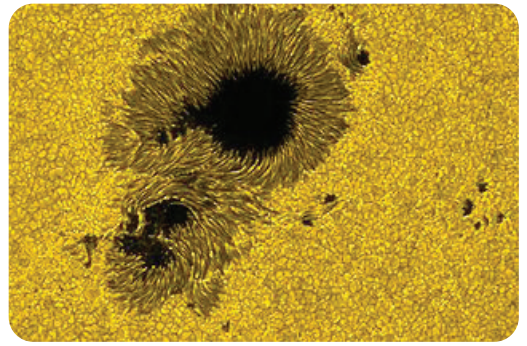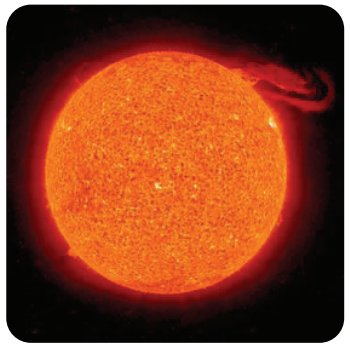INTRODUCTION
The Sun is the closest star to us. The life of the people of Earth depends on it. Therefore, it hass the most studied since ancient times. And yet there are still a number of questions that have not been answered by the science. In this part we will get acquainted with the main physical characteristics of the Sun, with its structure and manifestations of its activity that affect life on Earth.
Sun as a Star: Evolution of the Sun
The Sun is the closest star to us. It is at a distance of 149 600 000 km from us, which astronomers use as a unit of measure - an astronomical unit (AU). Light travels this distance in eight minutes, meaning that if an event occurs on the Sun, we will only see it after eight minutes. The Sun’s mass is 330 000 times that of the Earth, and its radius is 110 times larger than the Earth’s.
The Sun does not rotate uniformly, like a solid body would: the area around the Sun equator rotates the fastest (c. 25 days), and the areas around the poles – the slowest (c. 30 days). This type of rotation is called a differential rotation and stems from the fact that the Sun is a ball of gas and not a solid body.
The Sun’s structure comprises the following elements: core, radiative energy transfer zone, convective zone, and the atmosphere.
The Sun’s core, which amounts to 25% of the whole radius, is home to extreme conditions: the temperature reaches 15.6 million kelvins, and the pressure is around 250 billion atmospheres. The nuclear fusion occurring in the Sun’s core keeps it shining and emitting light, and respectively supports life on Earth.
Above the core is the radiative zone, which makes up 75% of the Sun’s radius. The energy produced in the Sun’s core is transferred to the Sun’s surface through radiation in this zone.
The next layer is the convective zone, where energy is transported via material convection. This is the process of mixing colder and hotter layers of matter: the hot gas rises to the surface and then cools down, thus becoming more dense and accordingly sinks down again, where it heats up again. The process is similar to boiling water in a kettle. Energy is thus transferred from the hotter, inner layers to the Sun’s cooler, outer layers. The time for a so-called convective cell to rise to the surface is several decades.
The Sun’s atmosphere is above the convective zone. It can be divided into several layers: photosphere, chromosphere and corona. What we actually see of the Sun, in the visible spectrum, is the photosphere. Its temperature is around 5 800 K, and it is the coldest part of the Sun. It is very small – c. 300 km only. The photosphere consists of granules with an average size of around 1 000 – 2 000 km, which constantly appear and disappear for a period of 5-10 minutes. They are a result of convection that takes place below the photosphere, in the convective zone. The photosphere’s most notable feature are the sunspots. They are clearly delineated, dark areas in the photosphere, with a temperature 1 000 K lower than their surroundings (the image below shows the granulation and the sunspots). In the area where the sunspots are located, the magnetic field of the Sun is very strong – around 1 000 G (the average effective magnetic field of the Sun is 1G). The spots usually appear in groups.

Situated above the photosphere is the solar chromosphere, where the gas is both more diluted and more transparent. The chromosphere measures c. 10 000 – 15 000 km, and its density is thousands of times less that of the photosphere. The temperature surges as the height increases, which is the result of the magnetic field and the radiation coming from the convective zone. Plasma eruptions occur in the chromosphere, whereby a huge amount of matter and energy is ejected explosively. These phenomena are called chromospheric solar eruptions and can influence the Earth’s magnetic field, thus causing electricity grid blackouts.
The Sun’s corona comes next. It has no visible boundary with the chromosphere. It stretches over a distance of tens of times the Sun’s radius, effectively moving into the interplanetary medium. The most impressive characteristic of the corona are the solar prominences (a prominence can be seen in the upper right corner of the image below). These are massive rainbow like, plasma eruptions, with temperatures of c. 20 000 K, which reach high above the Sun’s chromosphere, at height of 40 000 km from the surface. The solar prominences are formed in the areas above the sunspots, where the magnetic field is very strong.
The corona’s temperature is very high – to the order of millions of degrees, and the particle speed there is also very high. As a result, the Sun’s gravitational field cannot hold them, and they escape the Sun at a speed of several hundred to a thousand km/h. This outer part of the corona is referred to as the solar wind.

The Sun’s evolution is of particular interest to us as it is the only star, about which we know all key physical characteristics: the exact radius, mass, luminosity and temperature. The chemical composition is also known with a high degree of certainty.
What has happened to the Sun so far and what lays ahead for it? It was born out of a cloud of dust and gas, as all other stars. After the gravitational collapse, it became a star. As temperature started rising, nuclear fusion started, which made it into a star. Following this, the Sun entered the Main sequence of its life, where it is at today. It is expected to remain in this stage for a few billions of years more, following which its luminosity will start to increase, pushing it from the Main sequence to the red giant stage of its life. This will be caused by the depletion of hydrogen in its core. Its radius will increase and accordingly will its luminosity. According to current estimates, the Sun will turn into a red giant in about five billion years. At this stage, it would have expanded to the orbit of Mars making the Earth inhabitable. After the red giant stage, comes the last stage of a star’s life – accompanied with the formation of a nebula, it will end its life as a white dwarf after about 7.5 billion years.


